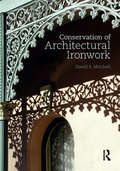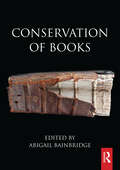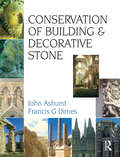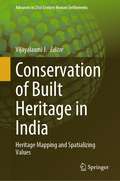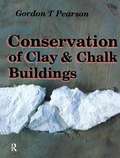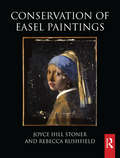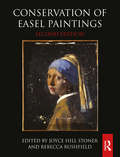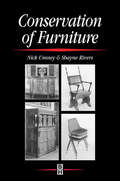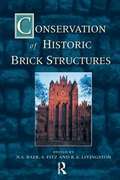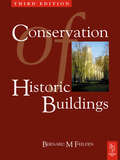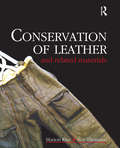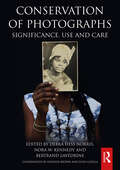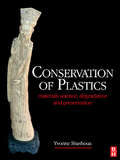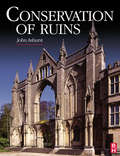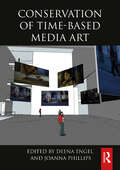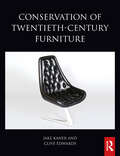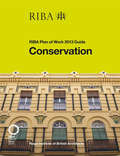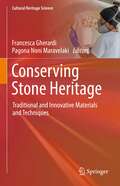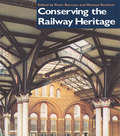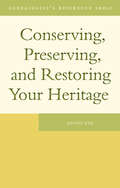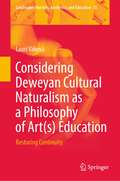- Table View
- List View
Conservation of Architectural Ironwork
by David S. MitchellThe peak of architectural ironwork in the 19th Century saw the spread of ornate decorative ironwork across the world. In recent years there has been a significant increase in conservation and restoration projects aiming to protect the artistry of traditional ironwork for future generations. Conservation of Architectural Ironwork is the first book to provide a complete guide to the conservation and maintenance of traditional architectural ironwork. First introducing the contextual history and key material features of architectural ironwork, the book goes on to guide readers through the management and delivery of conservation projects from start to finish, explaining the very latest in conservation technology. At its peak, architectural ironwork was used on a vast global scale in buildings, bridges, street furniture and ornamental structures. With international case studies and detailed illustrations, this book will be an essential reference for heritage professionals and students of architectural conservation around the world.
Conservation of Books (Routledge Series in Conservation and Museology)
by Abigail BainbridgeConservation of Books is the highly anticipated reference work on global book structures and their conservation, offering the first modern, comprehensive overview on this subject. The volume takes an international approach to its subject. Written by over 70 specialists in conservation and conservation science based in 19 countries, its 26 chapters cover traditional book structures from around the world, the materials from which they are made and how they degrade, and how to preserve and conserve them. It also examines the theoretical underpinnings of conservation: what and how to treat, and the ethical, cultural, and economic implications of treatment. Technical drawings and photographs illustrate the structures and treatments examined throughout the book. Ultimately, readers gain an in-depth understanding of the materiality of books in numerous global contexts and reflect on the practical considerations involved in their analysis and treatment. Conservation of Books is a quintessential reference work for book conservators and anyone working with books, such as collection managers, librarians, curators, dealers, collectors, historians, and related professionals. It is also an indispensable text for students to complement hands-on training in this field.
Conservation of Building and Decorative Stone (Butterworth-heinemann Series In Conservation And Museology)
by F G Dimes J. AshurstOne of the problems which beset the practical conservation of stone buildings is the fragmentation of the disciplines involved. This book, with both volumes now available as one invaluable paperback, brings these disciplines together by the involvement of contributors with different experiences and approaches to the same material. Part one is an introduction to the complexities and background history of stone conservation followed by the most comprehensive description yet produced of the building and decorative stones used in the British Isles.In part two, practitioners involved in stone conservation describe ways in which major structural masonry problems, secondary building problems and different stone surface conditions may be treated. A variety of building types and environments has been used to ensure that the broad scope of common problems is covered. This second part of the book will be of practical value to art historians, archaeologists, architects, surveyors and engineers, masonry contractors and sculpture conservators in solving problems and in learning to use each other's skills and experience.
Conservation of Built Heritage in India: Heritage Mapping and Spatializing Values (Advances in 21st Century Human Settlements)
by Vijayalaxmi J.This book focuses on the Heritage Conservation of Architecture, Historic Districts of a City and Conservation strategies with specific case studies from India, in order to highlight the need for conserving the rich piece of history through research, education, advocacy, and practice. The historic significance and the condition mapping of the subjects are carried out through primary field studies by the authors at School of Planning and Architecture, Vijayawada, India. The cases are analysed, and appropriate solutions and sustainable strategies are evolved for the conservation of the buildings facing contemporary challenges. The contents align with the Sustainable Development Goals (SDG 11), Target 11.4 which aims to “strengthen efforts to protect and safeguard the world's cultural and natural heritage'. This would ensure that a rich piece of history is documented and analysed to ensure that it is not erased and forgotten. This book serves as a bountiful data base of literature as well as conservation strategies for heritage conservationists, students of architectural conservation and researchers.
Conservation of Clay and Chalk Buildings
by Gordon T. PearsonThis publication provides practical guidance on appropriate methods of conservation and repair of earth buildings using traditional building materials. It is the first major work on the subject since Clough Williams-Ellis and the Eastwick-Fields published "Building in Cob, Pise and Stabilized Earth" in 1947. The book deals with the nature of clay and chalk, their qualities and characteristics, and the way in which they have been used to construct buildings. Advice is given on soils analysis, the philosophy of repair techniques and the factors to be considered before altering, converting or extending an earth building. The author primarily advocates repair techniques using traditional materials, but he also considers the role played by certain modern materials, and assesses their suitability.
Conservation of Easel Paintings (Routledge Series in Conservation and Museology)
by Joyce Hill Stoner Rebecca RushfieldConservation of Easel Paintings is the first comprehensive text on the history, philosophy, and methods of treatment of easel paintings that combines both theory with practice. With contributions from an international group of experts and interviews with important artists, this volume provides an all-encompassing guide to necessary background knowledge in technical art history, artists' materials, scientific methods of examination and documentation, with sections that present varying approaches and methods for treatment, including consolidation, lining, cleaning, retouching, and varnishing. The book concludes with a section featuring issues of preventive conservation, storage, shipping, exhibition, lighting, safety issues, and public outreach. Conservation of Easel Paintings is a crucial resource in the training of conservation students and will provide generations of practicing paintings conservators and interested art historians, curators, directors, collectors, dealers, artists, and students of art and art history with invaluable information and guidance.
Conservation of Easel Paintings (Routledge Series in Conservation and Museology)
by Stoner, Joyce Hill / Rushfield, RebeccaConservation of Easel Paintings, Second Edition provides a much-anticipated update to the previous edition, which has come to be known internationally as an invaluable and comprehensive text on the history, philosophy and methods of the treatment of easel paintings. Including 49 chapters written by more than 90 respected authors from around the world, this volume offers the necessary background knowledge in technical art history, artists’ materials and scientific methods of examination and documentation. Later sections of the book provide information about the varying approaches and methods for treatment and issues of preventive conservation, as well as valuable reflections on storage, shipping, and exhibition. Including exciting developments that have taken place since the last edition was published, the book also covers new techniques of examination, especially MacroXRF scanning and Reflectance Transmission Imagery. Drawing on research presented at recent professional conferences, information about innovative methods for cleaning modern and contemporary paintings and insights into modern oil paints is also included. Incorporating the latest regulations and understanding of health and safety practices and integrating theory with practice throughout, Conservation of Easel Paintings, Second Edition will continue to be an indispensable reference for practicing conservators. It will also be an essential resource for students taking conservation courses around the world.
Conservation of Furniture (Routledge Series In Conservation And Museology Ser.)
by Shayne Rivers Nick UmneyThis book is a comprehensive resource covering the principles and practice of the conservation and restoration of furniture, and other decorative art objects made wholly or partly of wood. It integrates theory with practice to show the principles which govern interaction between wooden objects, the environmental and conservation treatments and the factors which need to be taken into account to arrive at acceptable solutions to conservation problems.The practical knowledge and experience of a team of conservators active in the field are bought together with theoretical and reference material from diverse sources and unified within a systematic framework. Specialist conservators from related disciplines cover diverse materials often incorporated into furniture.
Conservation of Historic Brick Structures
by Norbert Baer Fitz LivingstoneDespite the widespread use of brick construction throughout the world, there has been no major investigation into its deterioration and durability. This book provides the results of a major international study led by West Germany which examines the causes of decay in addition to the treatment and methods of conserving brickwork and historic mortars. The deterioration mechanisms discussed cover bio deterioration, salt damage and the effects of air pollutants and moisture on masonry. Considerable attention is also devoted to historic mortars and renders, their analysis, behaviour under the stress of air pollution and the development of compatible modern formulations. Conservation methods for brick masonry, including de-salination, protective coatings and injection grouting are examined in detail. A useful and extensive range of case study material is also provided. This volume represents the most comprehensive, state of the art overview of the conservation of historic brick masonry, and will be an invaluable source of reference for all conservation practitioners and researchers working in this field.
Conservation of Historic Buildings
by Bernard FeildenSince its publication in 1982 Sir Bernard Feilden's Conservation of Historic Buildings has become the standard text for architects and others involved in the conservation of historic structures. Leading practitioners around the world have praised the book as being the most significant single volume on the subject to be published. This third edition revises and updates a classic book, including completely new sections on conservation of Modern Movement buildings and non-destructive investigation. The result of the lifetime's experience of one of the world's leading architectural conservators, the book comprehensively surveys the fundamental principles of conservation in their application to historic buildings, and provides the basic information needed by architects, engineers and surveyors for the solution of problems of architectural conservation in almost every climatic region of the world. This edition is organized into three complementary parts: in the first the structure of buildings is dealt with in detail; the second focuses attention on the causes of decay and the materials they affect; and the third considers the practical role of the architect involved in conservation and rehabilitation. As well as being essential reading for architects and others concerned with conservation, many lay people with various kinds of responsibility for historic buildings will find this clearly written, jargon-free work a fruitful source of guidance and information.
Conservation of Leather and Related Materials
by Marion Kite Roy ThomsonThe conservation of skin, leather and related materials is an area that, until now, has had little representation by the written word in book form. Marion Kite and Roy Thomson, of the Leather Conservation Centre, have prepared a text which is both authoritative and comprehensive, including contributions from the leading specialists in their fields, such as Betty Haines, Mary Lou Florian, Ester Cameron and Jim Spriggs.The book covers all aspects of Skin and Leather preservation, from Cuir Bouillie to Bookbindings. There is significant discussion of the technical and chemical elements necessary in conservation, meaning that professional conservators will find the book a vital part of their collection. As part of the Butterworth-Heinemann Black series, the book carries the stamp of approval of the leading figures in the world of Conservation and Museology, and as such it is the only publication available on the topic carrying this immediate mark of authority.
Conservation of Photographs: Significance, Use and Care (Routledge Series in Conservation and Museology)
by Heather Brown Luisa CasellaConservation of Photographs: Significance, Use and Care provides a comprehensive and inclusive overview of theory, research, and practice in the conservation of photograph collections, from the analogue to the digital era.Including insights from nearly 100 leading international professionals, this book is a tribute to the synergistic advancements in photograph conservation in recent decades. Connecting material, imaging, computational and natural sciences, aesthetics, ethics and philosophy, history, art history, art and cultural context studies, these engaging writings contextualize our photographic heritage and its long-term preservation – past, present, and future. This book explores the philosophical underpinnings and evolution of the field, before moving on to detail innovative methodologies for assessing photographic heritage. The inclusion of material on characterization, imaging and authentication studies, conservation practice, innovation and ethical constraints, as well as on current approaches to effective collections management and preventive care, ensures that this volume is an invaluable resource and important practical reference.Conservation of Photographs: Significance, Use and Care will spark a collective drive towards a more complete understanding and preservation of the world’s photographic legacy. As such, the volume is useful for scholars, students, and practitioners working in the fields of photography, conservation, art, art history, history, and cultural heritage.
Conservation of Plastics
by Yvonne ShashouaPlastic objects are included more than ever in museums and galleries collections these days, but these items can start to deteriorate when they a just a few years old. In this book Yvonne Shashoua provides the essential knowledge needed to keep plastic pieces in the best possible condition so that they can continue to be enjoyed for many years. The historical development of plastics, as well as the technology, their physical and chemical properties, identification, degradation and conservation are all clearly and concisely covered within this single volume, making it an invaluable reference for the increasing number of conservators and curators that are encountering plastics in their day to day work.
Conservation of Ruins
by John AshurstDespite growing international awareness of the presence and significance of ruined buildings and archaeological sites, and the increasingly sophisticated technology available for the collection of data about them, these sites continue to be at risk across the globe. Conservation of Ruins defines and describes these risks, which range from neglect, to destructive archaeology, and even well-meaning intervention in the name of tourism. The book provides detailed, practical instruction on the conservation and stabilisation of ruins by structural and non-structural means, as well as describing the procedures and conditions that need to be in place to ensure the protection of our important historic sites. In considering aspects of architectural conservation, archaeology and ecology together for the first time, this book provides an integrated, holistic view of this international topic that will be essential reading for those working in this field
Conservation of Time-Based Media Art (Routledge Series in Conservation and Museology)
by Deena Engel Joanna PhillipsConservation of Time-based Media Art is the first book to take stock of the current practices and conceptual frameworks that define the emerging field of time-based media conservation, which focuses on contemporary artworks that contain video, audio, film, slides or software components. Written and compiled by a diverse group of time-based media practitioners around the world, including conservators, curators, registrars and technicians among others, this volume offers a comprehensive survey of specialized practices that have developed around the collection, preservation and display of time-based media art. Divided into 23 chapters with contributions from 36 authors and 85 additional voices, the narrative of this book provides both an overview and detailed guidance on critical topics, including the acquisition, examination, documentation and installation of time-based media art; cross-medium and medium-specific treatment approaches and methods; the registration, storage, and management of digital and physical artwork components; collection surveys and project advocacy; lab infrastructures, staffing and the institutional implementation of time-based media conservation. Conservation of Time-based Media Art serves as a critical resource for conservation students and for a diverse professional audience who engage with time-based media art, including conservation practitioners and other collection caretakers, curators, art historians, collectors, gallerists, artists, scholars and academics.
Conservation of Twentieth-Century Furniture (Routledge Series in Conservation and Museology)
by Clive Edwards Jake KanerConservation of Twentieth-Century Furniture provides comprehensive and accessible coverage of the materials and techniques that are encountered in furniture of this century.After putting the design, manufacture and conservation of twentieth-century furniture into context, the volume then offers an A-Z of materials organised into 12 chapters. Within each chapter a wide variety of material types are discussed, observed, analysed and contextualised, and a list of further sources is provided. The furniture discussed in this book ranges from designer craftsman, individually made pieces, to factory-produced batch items, and includes cabinet work, decoration, surface finishes and upholstery, observing the traditional repertoire of materials, as well as innovative materials and processes introduced over the course of this century. Following the material chapters, the book also includes brief case studies that illustrate some examples of twentieth-century furniture conservation, with a focus on metal, plastic and wood.Conservation of Twentieth-Century Furniture is the primary resource for those working on the manufacture, history and care of furniture of this period, including conservators, curators, dealers and collectors.
Conservation: RIBA Plan of Work 2013 Guide
by Hugh FeildenConservation is part of a brand new series providing must-read practical guidance to running efficient and successful projects using the new RIBA Plan of Work 2013. Each guide takes a particular angle – in this case the author guides you through working on a conservation project - and explains the essential activities required at each stage. Concise and easy to use with a consistent format these guides provide the ultimate quick reference support at your desk or on-site. This is an authoritative ‘how to’ full of pragmatic advice, examples and in-text features such as ‘hints and tips’ that illuminate best practice and clever solutions. Designed to be used on all projects – large and small – and across all types of procurement, they are task rather than role-oriented acknowledging that a variety of people take on these responsibilities. They are also invaluable for architectural students at Part 3 who are getting to grips with the realities of practice.
Conserving 20th-Century Architecture: The Conservation Management Plan (Research for Development)
by Maria Paola Borgarino Davide Del CurtoThis book offers an international overview of how to apply the Conservation Management Plan (CMP) to the 20th-century architectural heritage. Although the CMP is universally considered a fundamental tool for sustainable management of the built heritage, the application to 20th-century buildings is still limited. The book illustrates selected case studies from different countries to discuss how best to preserve the authenticity of the original materials, manage changes in use, engage users and stakeholders in this process, and make conservation and sustainability work together. "Conserving 20th-century architecture" will provide insights for scholars and students and assist architects in drafting an effective conservation management plan.
Conserving Stone Heritage: Traditional and Innovative Materials and Techniques (Cultural Heritage Science)
by Francesca Gherardi Pagona Noni MaravelakiThe design of treatments for the conservation of stone in historical buildings and works of art is a challenging task, as a deep understanding of the working properties and performance of the available products and methods is required to tackle complex decay patterns.The chapters in this book illustrate the state of the art on traditional and innovative materials and methods for stone conservation, examining current trends and future perspectives. Each of them is focused on describing the consequent phases that complement the spectrum of the conservation intervention: preliminary investigations, condition assessment, and mapping of the deterioration patterns; surface cleaning, with a specific focus on laser technology; consolidation; protection; repair mortars and grouts; and onsite assessment and monitoring of conservation treatments. The performance of the applied conservation interventions is criticized and discussed with an aim of providing the specialists with specific tools for stone conservation. This book intends to bridge the gap between laboratory studies and conservation interventions, by linking together the diverse scientific areas involved in the preservation of stone heritage. Different case studies are included, highlighting specific conservation challenges and their solutions in order to understand and overcome them. The aim is to guide conservators, conservation scientists and heritage stakeholders in the selection of compatible and sustainable materials and techniques for Conserving Stone Heritage.
Conserving the Railway Heritage
by Michael Stratton Peter BurmanGreat Britain not only invented the main-line railway but has also led the way in it's preservation - not just locomotves and carriages but also the buildings and structures that bear witness to the confidence of railway developers, architects and engineers. This book defines the nature of the railway heritage - from signalboxes, viaducts, tunnels and locomotive depots - and then discusses priorities and the best practice for it's conservation. The subject is a strongly topical one due to current concern over privatization, the effects of planned high-speed rail links and lively debates concerning the role of the enthusiast in railway preservation.
Conserving, Preserving, and Restoring Your Heritage: A Professional's Advice
by Kennis KimArtifacts, whether found in museums, our community, or our homes, offer glimpses into the past. Be they documents, photographs, books, or clothing, as custodians of our history, we’re faced with how to maintain these items. Professional conservator Kennis Kim tells us how. Topics discussed include: creating an accession list; the nature of conservation, restoration, and preservation; deciding on display, storage, or using the artifact; common threats such as light, humidity, insects, and rodents; and when to call a professional. Here is all that’s needed to determine what can be done to preserve precious articles for future generations.|Kennis has a master of art conservation from Queen’s University and a master of art history and mater of museum studies from Syracuse University. She has worked for the National Art Gallery, Ottawa; the Museum of Fine Art, Boston; and the Textile Conservation Workshop, South Salem, New York. She lives in Toronto.
Consider the Lilies
by Alfreda Oko Martin Edward MartinJapanese flower arranging has attracted a world wide following, and this book is a simple and clear introduction to the art.The first section illustrates thirty-six suggested flower arrangements with diagrams and full how-to-do-it instructions. The second part of the book explains the theory and technique of Japanese flower arrangement. The result is a book which gives an astonishing range of flower arrangements, clear explanations of how to make them at home, and an inspiring selection of devotional passages.
Considering Deweyan Cultural Naturalism as a Philosophy of Art: Restoring Continuity (Landscapes: the Arts, Aesthetics, and Education #35)
by Lauri VäkeväThis book makes a case for cultural naturalism as a basis for a philosophy of art education. It argues for a holistic approach that avoids hard boundaries between artistic disciplines in the educational context, applying cultural naturalism to challenges that are topical for the whole art(s) education field, including challenges related to ecology, social justice, and technological transformation of culture. The book is written in the form of a conditional argument that considers the consequences of cultural naturalism for today’s philosophical problem-solving in art(s) education. It contains a systematic and historical analysis of cultural naturalism that support the philosophical reflection of educators and other scholars operative in this field. The result is a late modern reading of Deweyan cultural naturalism that highlights the continuance of key philosophical ideas from the modern to present discourses. The key topics discussed are of particular interest to present-day art(s) educators: ecological sustainability, social justice, and technological transformation of culture. In addition, this book provides an example of pragmatist argumentation, suggesting an alternative to analytical and post-philosophical approaches.
Considering Doris Day: A Biography
by Tom SantopietroThe biggest female box office attraction in Hollywood history, Doris Day remains unequalled as the only entertainer who has ever triumphed in movies, radio, recordings, and a multi-year weekly television series. America's favorite girl next door may have projected a wholesome image that led Oscar Levant to quip "I knew Doris Day before she was a virgin," but in Considering Doris Day Tom Santopietro reveals Day's underappreciated and effortless acting and singing range that ran the gamut from musicals to comedy to drama and made Day nothing short of a worldwide icon. Covering the early Warner Brothers years through Day's triumphs working with artists as varied as Alfred Hitchcock and Bob Fosse, Santopietro's smart and funny book deconstructs the myth of Day as America's perennial virgin, and reveals why her work continues to resonate today, both onscreen as pioneering independent career woman role model, and off, as a recipient of the Presidential Medal of Freedom, the United States' highest civilian honor. Praised by James Cagney as "my idea of a great actor" and by James Garner as "the Fred Astaire of comedy," Doris Day became not just America's favorite girl, but the number one film star in the world. Yet after two weekly television series, including a triumphant five year run on CBS, she turned her back on show business forever. Examining why Day's worldwide success in movies overshadowed the brilliant series of concept recordings she made for Columbia Records in the '50s and '60s, Tom Santopietro uncovers the unexpected facets of Day's surprisingly sexy acting and singing style that led no less an observer than John Updike to state "She just glowed for me." Placing Day's work within the social context of America in the second half of the twentieth century, Considering Doris Day is the first book that grants Doris Day her rightful place as a singular American artist.
Considering Ethics in Dance, Theatre and Performance
by Fiona BannonThis book asks important questions about making performance through the means of collaboration and co-created practice. It argues that we can align ethics and aesthetics with collaborative performance to realise the importance of being in association with one another, and being engaged through our shared imaginations. Evident in the examples of practice visited in this study is the attention given by a number of practitioners to the development of shared, co-operative modes of creation. Here, we can appreciate ethical work as being relational, forged in association with the others as we cultivate ideas that matter.In looking at a range of work from practitioners including Meg Stuart, Rosemary Lee, Deufert&Philschke and Fevered Sleep, Considering Ethics in Dance, Theatre and Performance explores ways that we rehearse by attending to ethics, aesthetics and co-creation. In learning to listen, to observe, to co-operate and to negotiate, these practitioners reveal the ways that they bring their work into existence through the transmission of shared meaning.
